First Steps in eWay-CRM
Get Familiar with eWay-CRM Fast.
Tutorial for
eWay-CRM Desktop
- First Look
- Integration With Outlook Emails
- Integration With Outlook Calendar
- Integration With Outlook Contacts
- Integration With Microsoft Word / Excel
- Modules
- List of Items
- Item Detail
- Data Entry
- Relations
First Look
Once you have installed eWay-CRM, start Microsoft Outlook to get a new tab eWay-CRM on the Microsoft Outlook ribbon.

There is also a new icon in your system tray area. It’s called eWay Agent and it shows you the status of the synchronization.

 | All items are synchronized. The displayed data are up-to-date. |
 | The synchronization of items with the server is running or eWay-CRM is just now connecting to the server. |
 | The connection to the server is not available at this time – as soon as the connection is restored, synchronization will run automatically. |
 | eWay-CRM is offline at the moment – you can cancel this setting by right-clicking the eWay Agent icon and canceling the Work Offline option. This mode allows you to work with your data even without a connection to the internet or the server. |
 | You have new eWay-CRM Desktop update available and you can install it. |
 | eWay-CRM Desktop is logging in to its account. |
 | eWay-CRM invoice is 3 days past due. The application is in the 10-day period when you can still use all its functions. |
 | eWay-CRM Desktop is launching. |
Integration With Outlook Emails
Right-click on an incoming email. You will find four new options: Save to eWay-CRM, Save Attachments to eWay-CRM, GDPR Relevant, Convert to Task, Convert to Deal, Convert to Project, Convert to Contact and Convert to Journal.
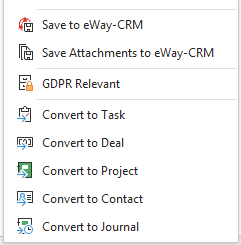
Open an email, you will find new buttons for these options there as well.

Notice that at the bottom part of your emails, a small toolbar— Superior Item — will appear. It will allow you to link emails to deals or projects.
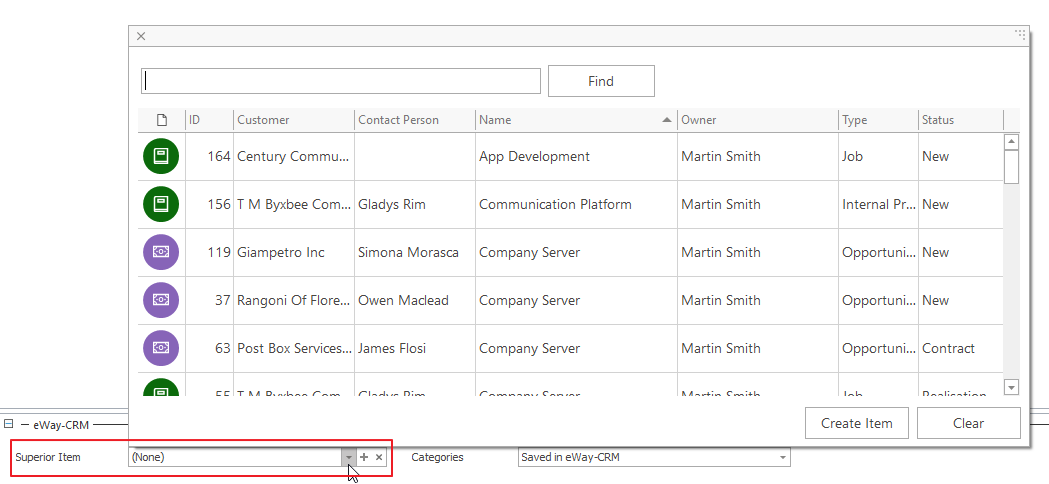
Integration With Outlook Calendar
You can convert a calendar event to time sheets or a journal and tie it with a contact, company, deal, or project.
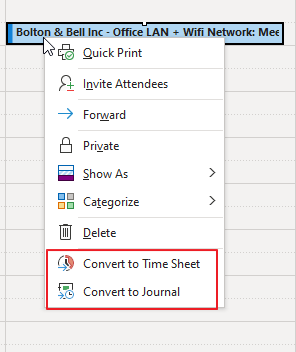
Integration With Outlook Contacts
In your Outlook contacts you will find three new buttons: Save to eWay-CRM, Synchronize With eWay-CRM, and Open in eWay-CRM.

Integration With Microsoft Word / Excel
eWay-CRM integrates with Microsoft Word and Microsoft Excel. Pay attention to a new button: Save to eWay-CRM in an open file.

Modules
eWay-CRM has various modules to meet a wide range of requirements, but we recommend that you pay attention to the most popular modules first:
- Companies and Contacts are usually used to track existing clients and vendors.
- Deals are great for tracking business opportunities. They contain workflow that helps you move them through the sales pipeline. Deals can be converted into Projects, Companies and Contacts.
- Projects allow tracking jobs and deliveries. If somebody closes a deal, projects are the best place to manage all steps required to successfully finish the job.
- Marketing helps all who need to send email campaigns and analyze responses.

List of Items
When you click on a module, you will see the list of items (provided that you have uploaded sample data or created your own items).

It has the look and flexibility of a spreadsheet. You can add and remove columns, filter and group data or create advanced filters. Once you created a custom layout, you can save it for future use. Learn more in the article Create Grid Reports.
eWay-CRM also allows you to use conditional formatting similar to Microsoft Excel. Colors, icons, data bars, and color scales will make your data even more well-arranged.
Item Detail
Each item detail has sections for basic, contact, and additional information as well as a special tab where you can see all changes tat where done to the item. Let’s have a look at the deal detail.
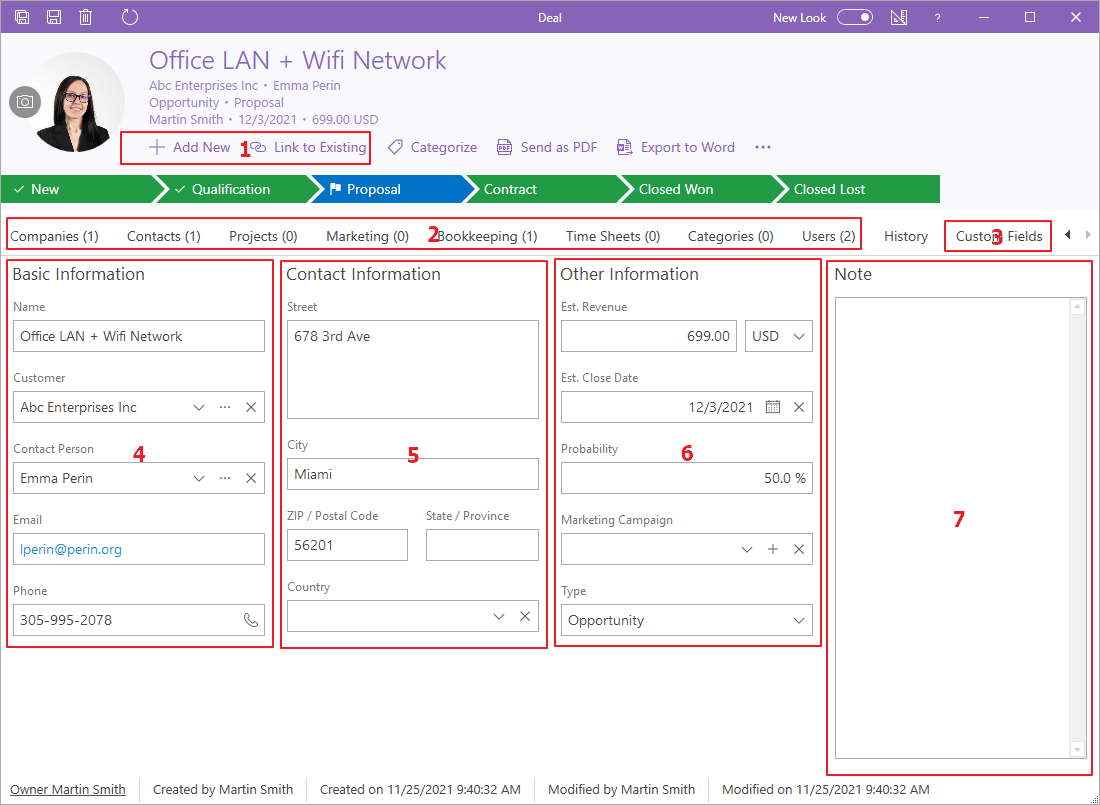
| Number | Description |
| 1 | Add New/Link to Existing buttons at the top of each item detail allow you to make relations with new records/items (emails, tasks, notes, etc.) or already saved in eWay-CRM before. |
| 2 | All activities related to these specific items will be displayed under the special panel with tabs. |
| 3 | You can create an unlimited number of custom fields. Some of them will be displayed right here. If there are many custom fields, they can be found on the special “Custom Fields” layout. Learn more about custom fields here. |
| 4 | Basic Information such as names and contacts. |
| 5 | Contact Information |
| 6 | Other Information |
| 7 | Notes fields can be used for general or important information you always want to keep an eye on. |
Data Entry
There are different ways for you to put data into eWay-CRM. You can:
- Import contacts and companies from Microsoft 365
- Import contacts and companies from Outlook
- Import contacts and companies from Excel
- Create contacts and companies manually
eWay-CRM uploads items into the server (which sits either in our Cloud or on your servers). If you get a new PC and sign in, the server database will be automatically synchronized your data onto your new device.
Relations
The basic of eWay-CRM is work with relations so you can have related all items that are connected – e.g. have all communication, documents and contacts on project, etc. In the item detail just click Add New to add new item – only select which one.
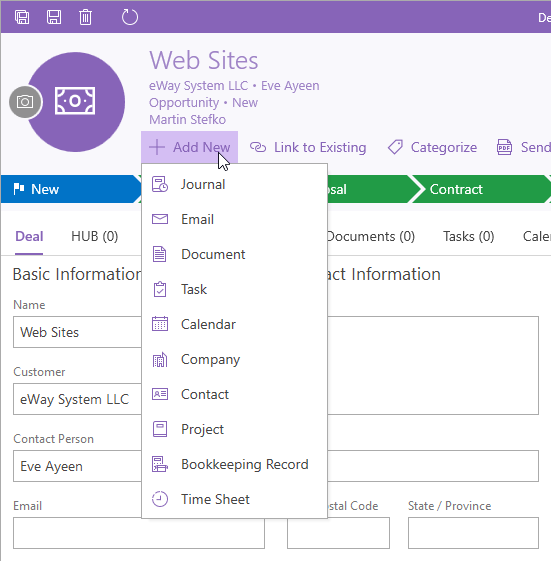
If the item you want to relate is already existing, just click Link to Existing and select from which module.
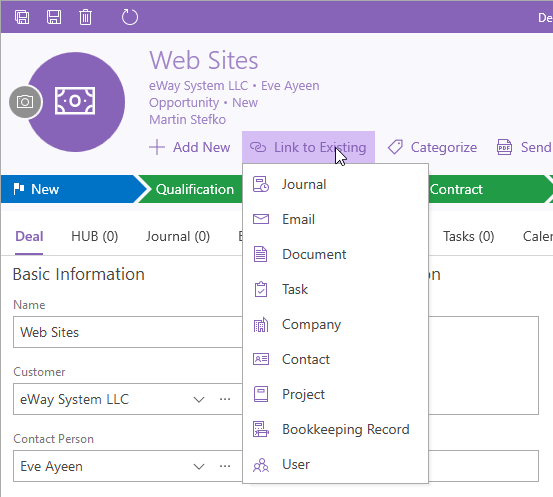
There i no need to open an item detail to add some relation, you can easily do it right in the list of items. Just right-click an item – you can see Add New and Link to Existing too.
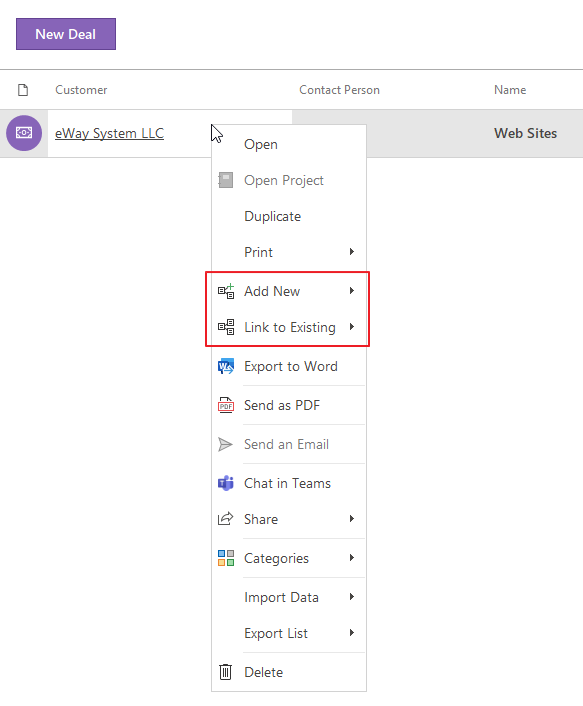
All related items can be found in the tab system on the item detail. Did you add an email? It is in the Emails tab or in HUB.
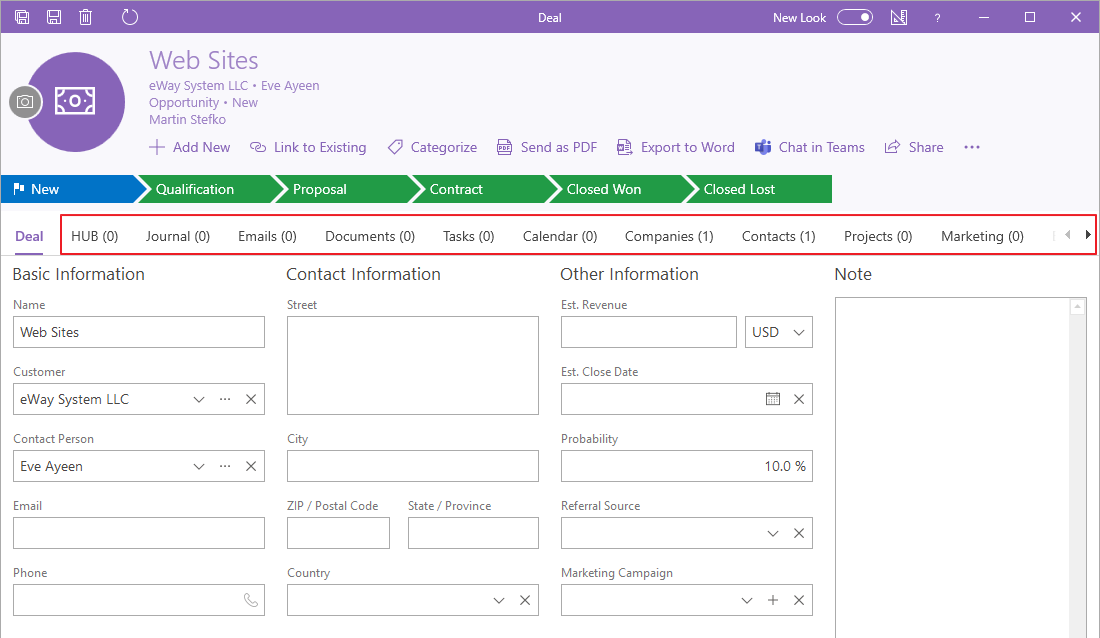
eWay-CRM Online
First Look
If you installed eWay-CRM Online, you can find it under the Apps icon on any e-mail.
If you click the Apps icon, click Best CRM for Outlook.
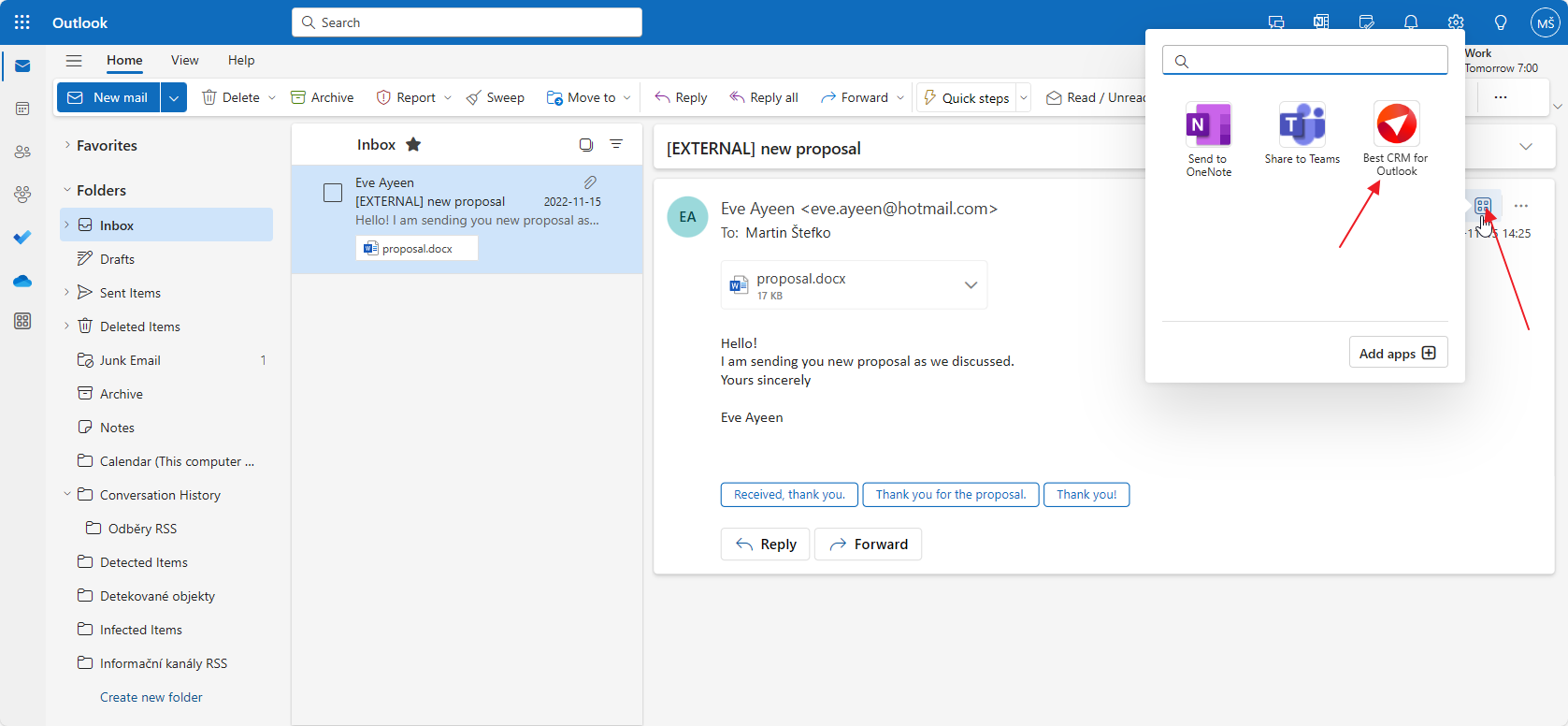
If you click the icon, you have several options. You can create a new item, open one of our modules, or show a preview panel.
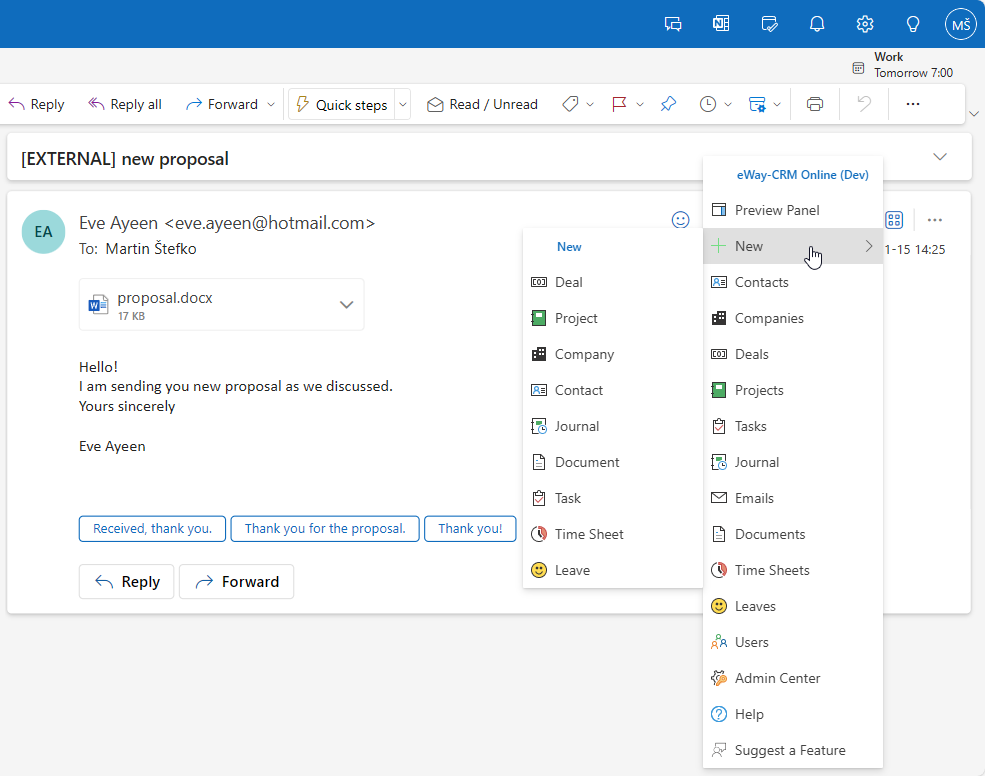
Preview Panel
The Preview Panel allows you to see information about a contact related to an email. To open this panel, click the eWay-CRM icon in the email and select Preview Panel.
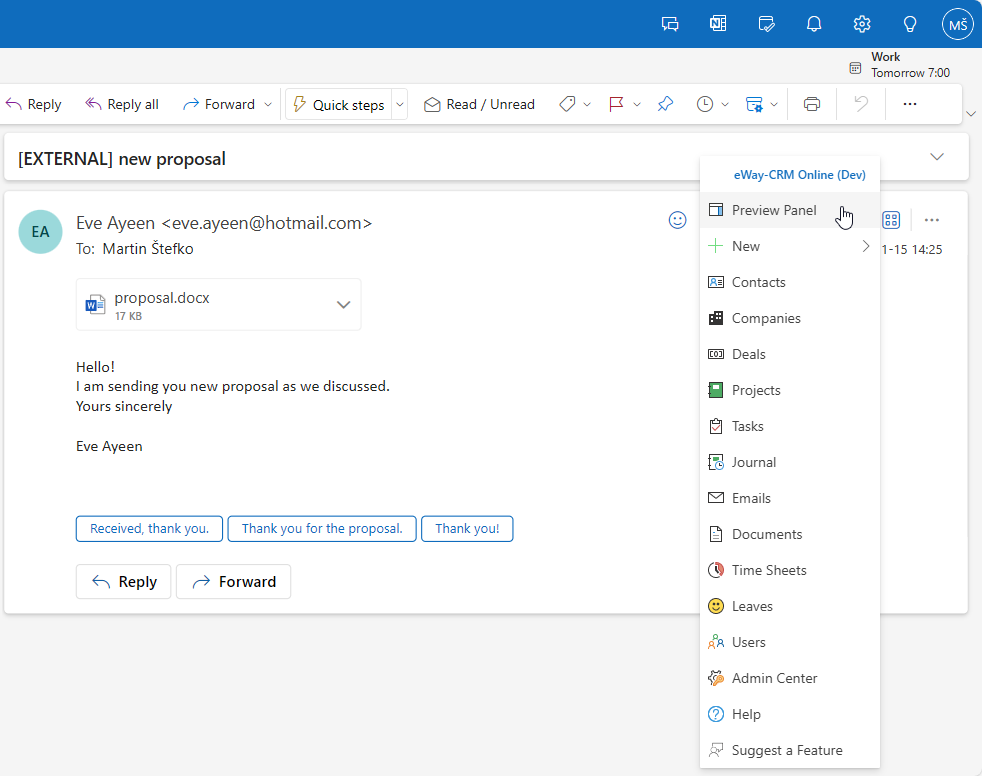
The panel will appear to the right of your inbox allowing you to see the details. You can pin the add-in panel, ensuring that it’s always visible in.
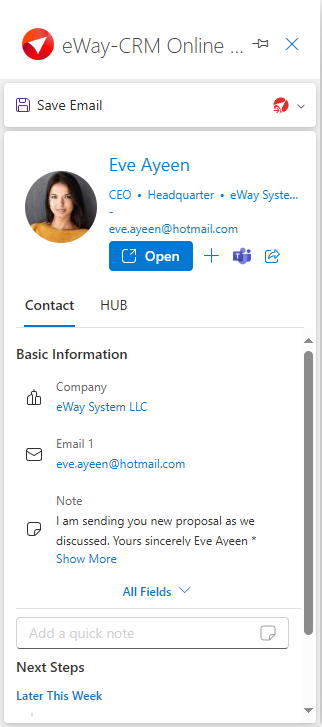
You can save the selected email to eWay-CRM, so it will always be related to a contact, company, or deal.
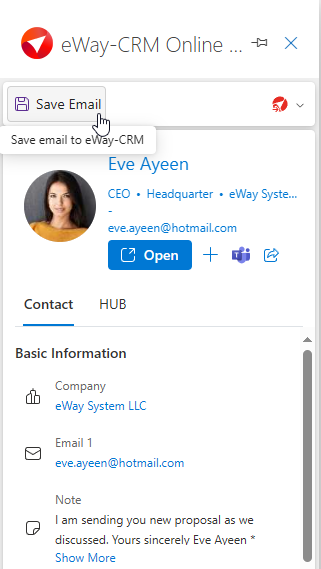
You can convert the email to a new contact, deal, or project, create a task for follow-up or just a journal for general notes.
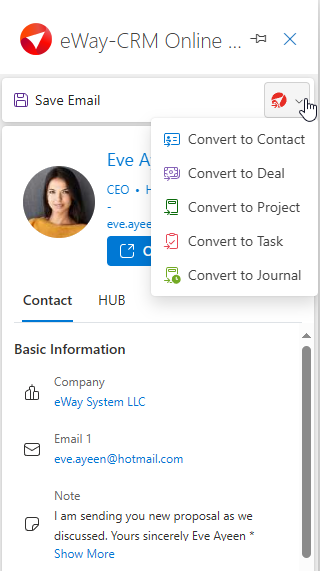
You can also add a note that will be saved as a journal and automatically related to the contact.
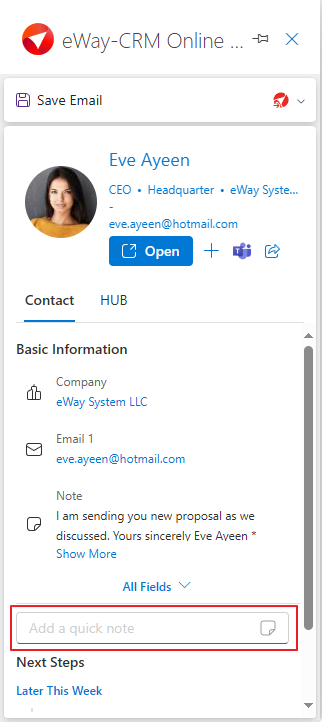
In the HUB, you can see all important items that are related to the contact. If you want to open an item, just double-click it.
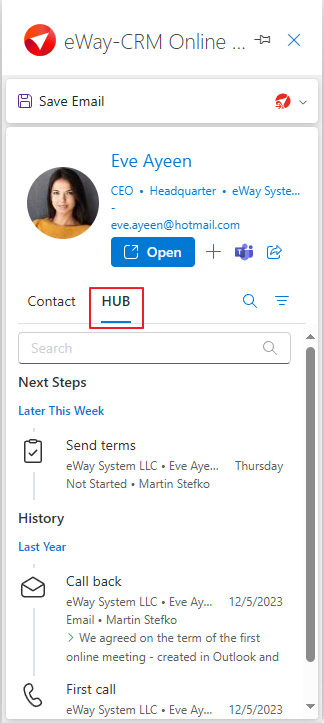
List of Items
Click the eWay-CRM icon in the email body and select a module. A pop-up with the list of items will open.
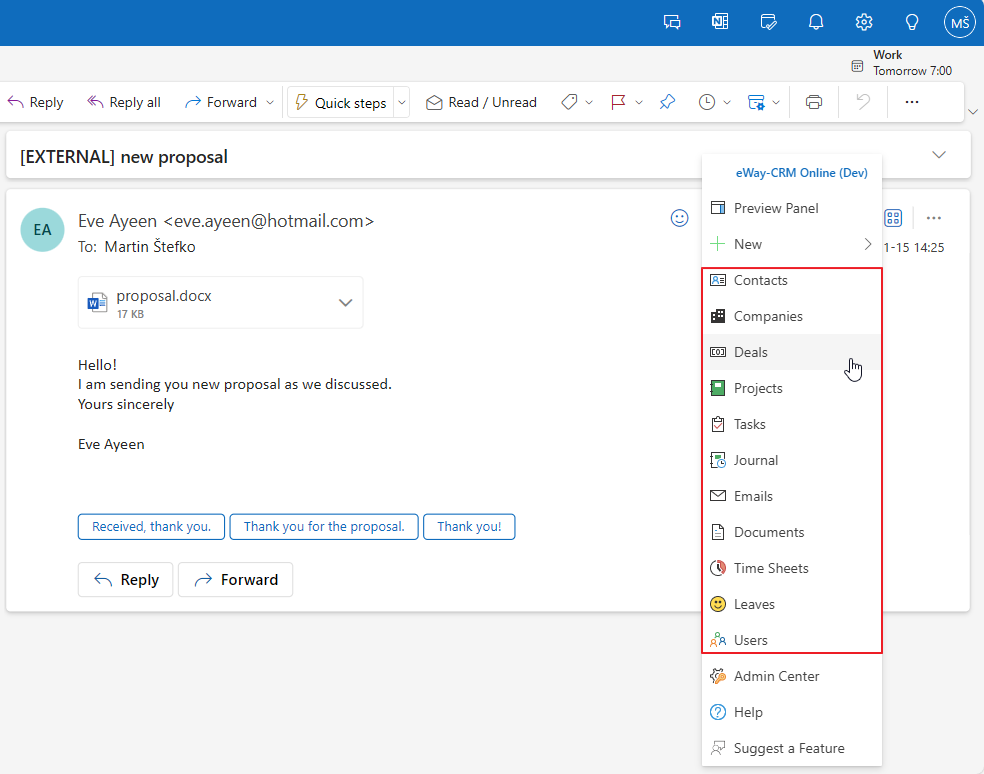
You will see this working environment (this is an example for deals in the Board view, but you may see standard list depending on your settings of module view):
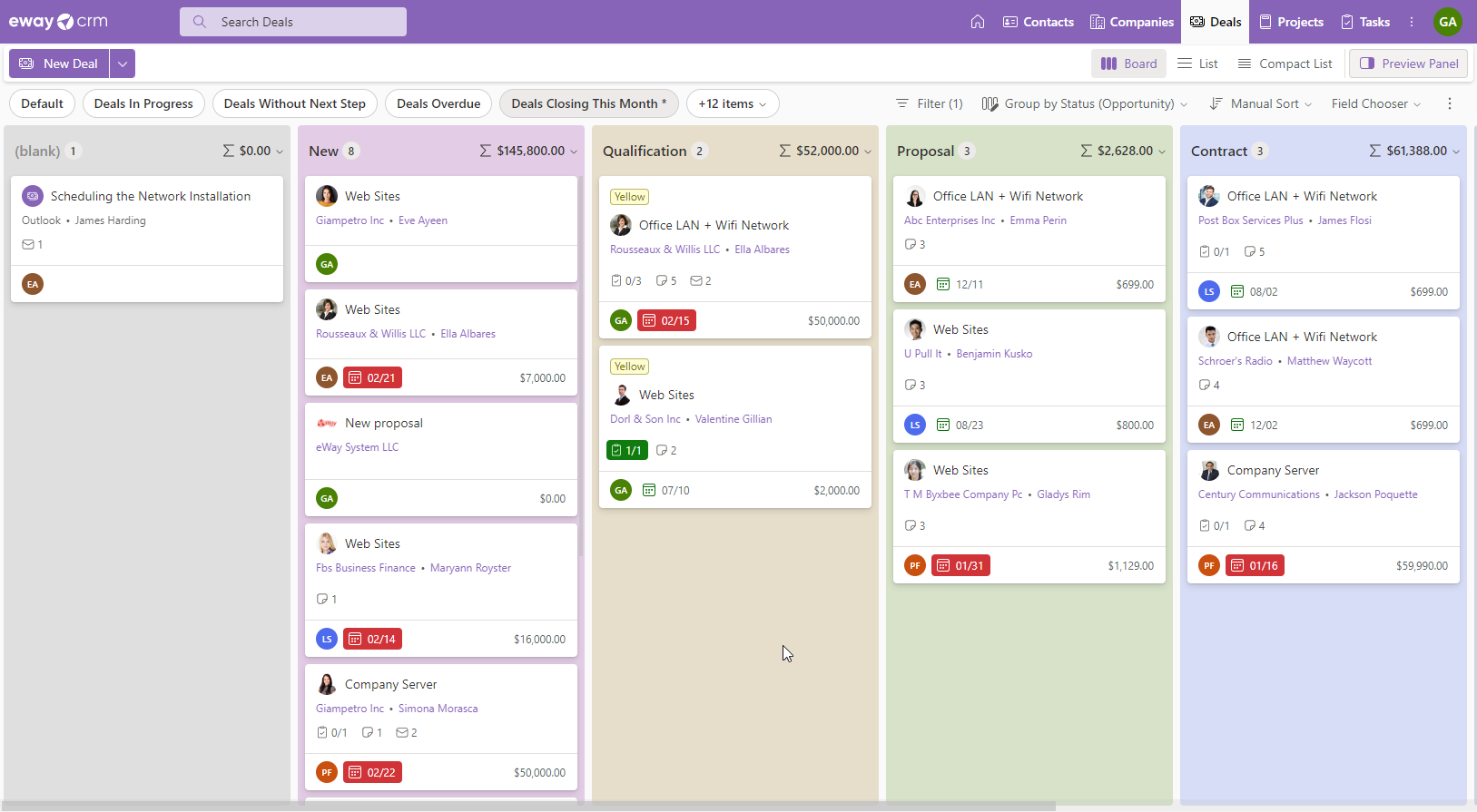
In the left part of the top ribbon, you can search in the current list (see How to Filter Items). In the right part, there are all modules that you have access to.

In the right top corner, there is a button for your account:
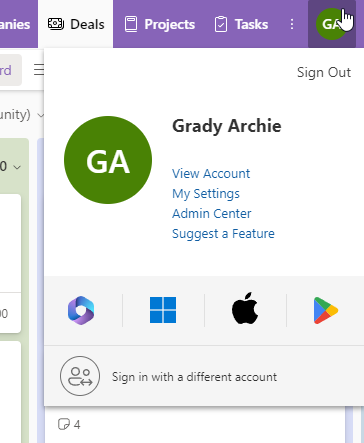
- Sign Out – log out from your eWay-CRM Web account
- View Account – open detail with information about your user account
- My Settings – you can change eWay-CRM Web settings (e.g. language settings)
- Admin Center – if you are an administrator, you can go to Administration Center
- Suggest a Feature – you will be redirected to the web where you can suggest functions that you would like to see in eWay-CRM
- Download icons – get the correct version of eWay-CRM for your platform
- Sign in with different account – you can sign in using a different account
The basic element of the page is the list of items. There you can see all items you have permission to see for the selected module. You can filter items and work with the list.
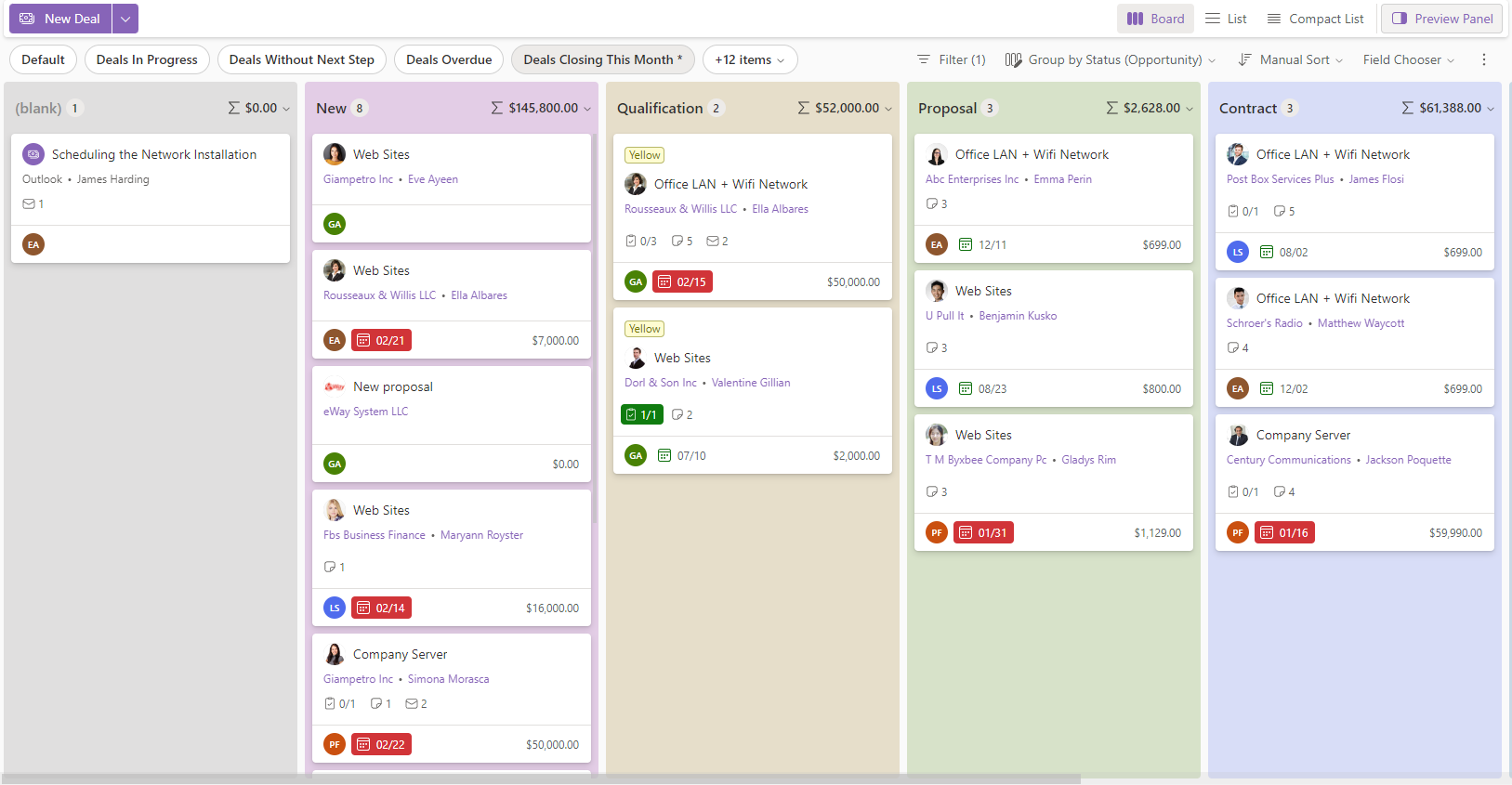
The top part gives you the option to create new items:
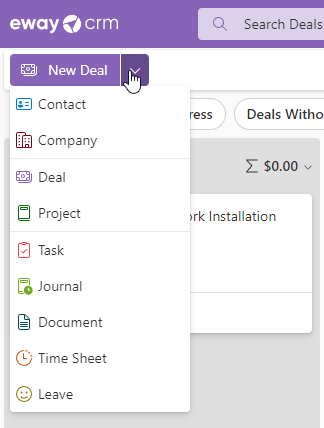
List views have the look and flexibility of a spreadsheet. You can add and remove columns, filter and group data or create advanced filters. Once you have created a custom layout, you can save it for future use. Learn more in the article Create Grid Reports.
Item Detail
You can open an item from the preview panel when you click the Open button:
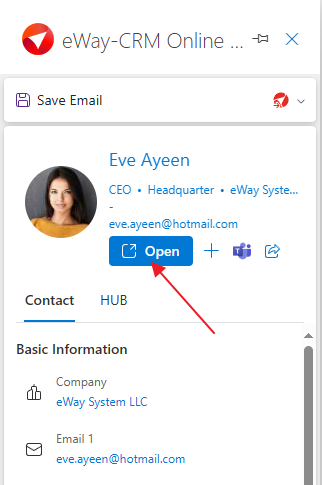
This launches the Contact / Deal / Project etc. where you can make changes and save them, or you can see all relations to this item.
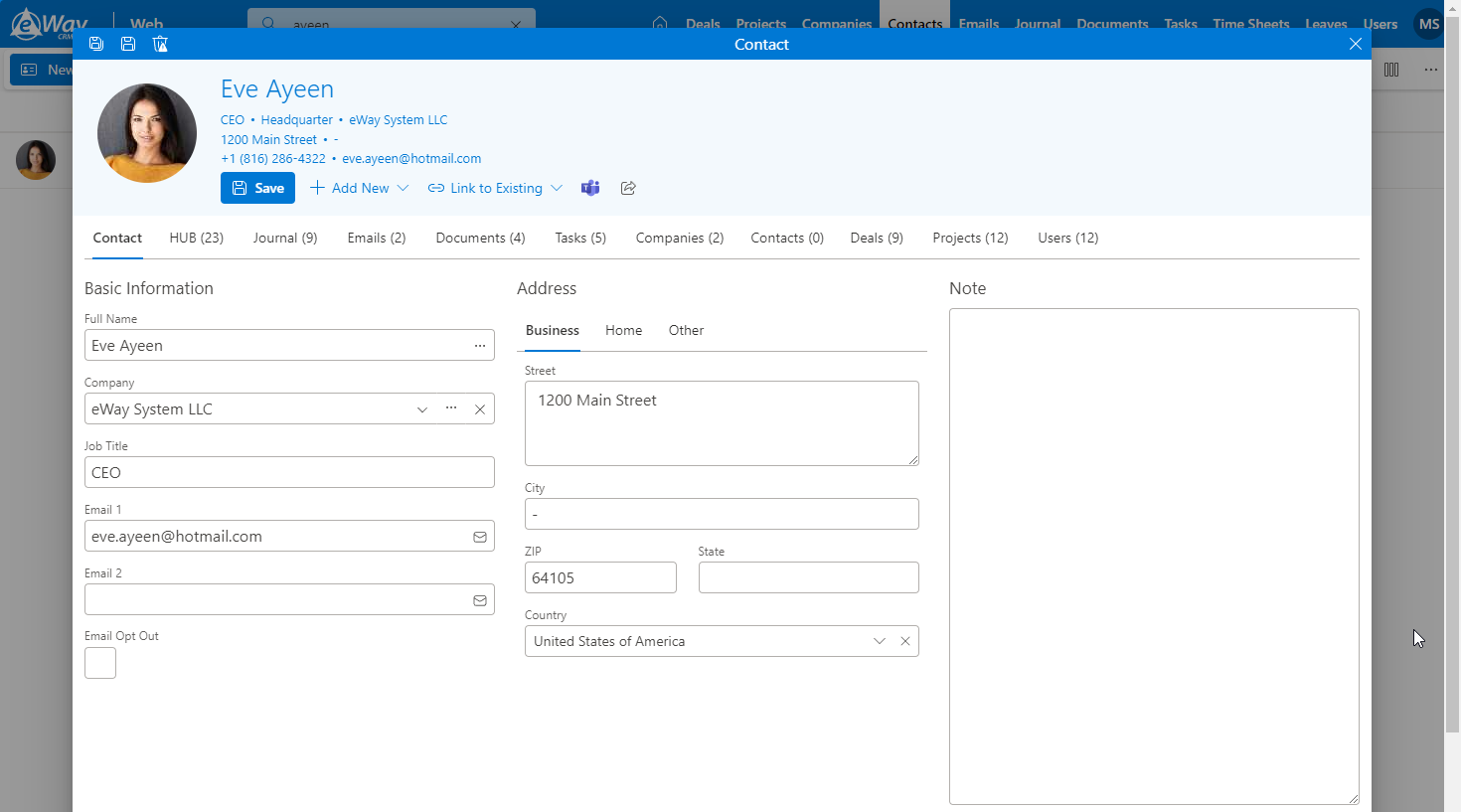
Data Entry
There are different ways for you to put data into eWay-CRM. You can:
- Import contacts and companies from Microsoft 365
- Import contacts from emails
- Create contacts and companies manually
eWay-CRM uploads items into the server (which sits either in our Cloud or on your servers). If you get a new PC and sign in, the server database will automatically synchronize your data onto your new device.
Relations
The main function of eWay-CRM is creating relations so you can connect all related items – e.g. have all communication, documents and contacts in a project, etc. In the item detail just click Add New to add a new item – and select what you want to create. which one.
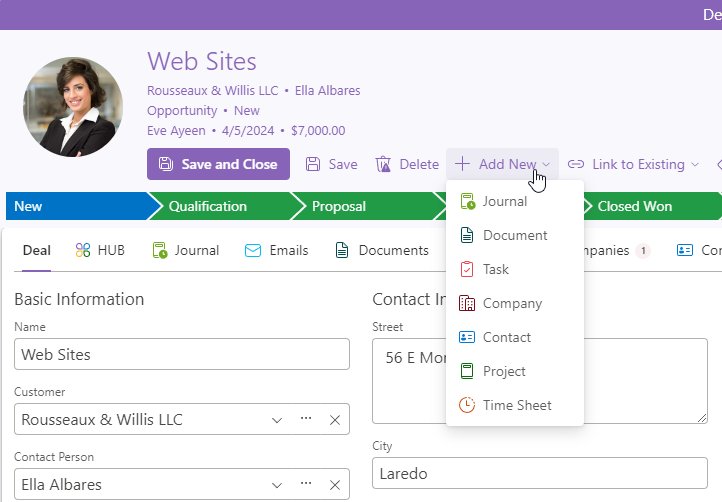
If the item you want to relate is already existing, just click Link to Existing and select from which module.
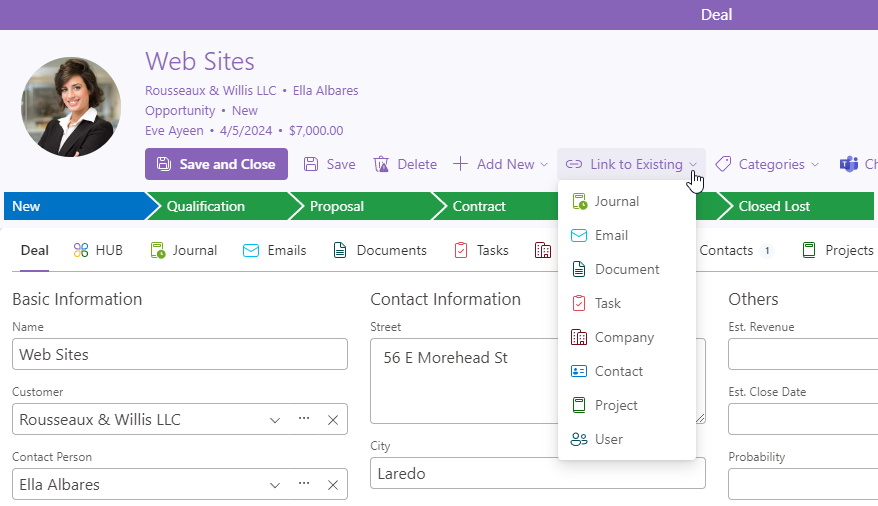
There is no need to open an item detail to add a relation. You can also easily do it right in the list of items. Just right-click an item to find the options Add New and Link to Existing.
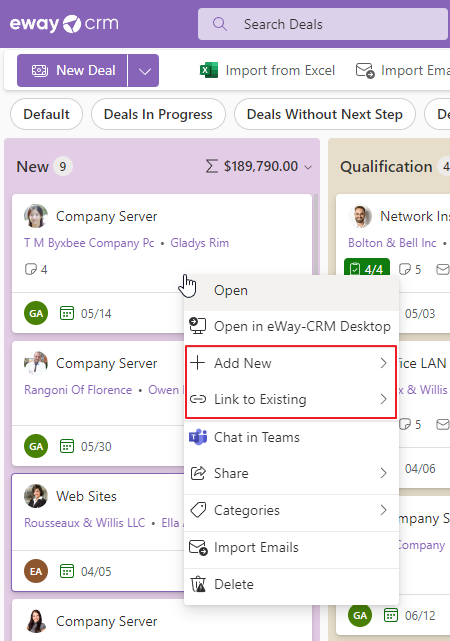
All related items can be found in the tab system on the item detail. Did you add an email? It is in the Emails tab or in HUB.

eWay-CRM Mobile
First Look
When you open eWay-CRM Mobile for the first time, you will be asked to log in. Please login with your eWay-CRM account, or you can sign up.
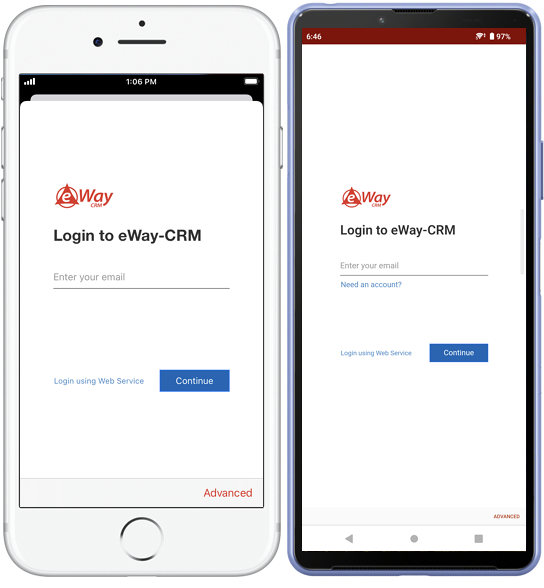
After successful login and the initial synchronization, you will see the main screen of eWay-CRM Mobile with modules that are available in the application. Just tap one of them to see the list of its items.
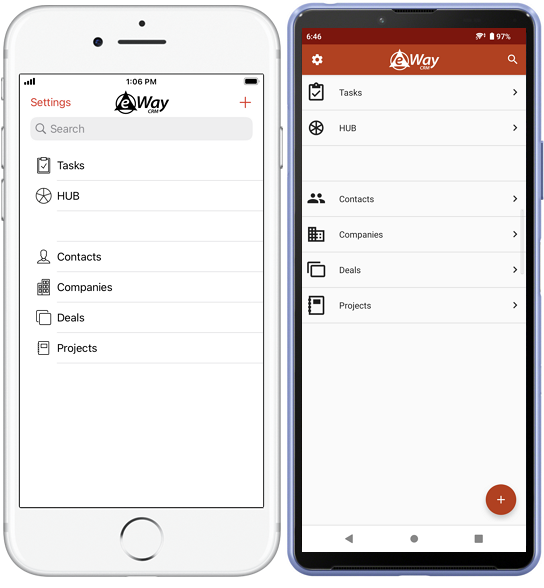
List of Items
The list of items shows all items of the module the user has permission to see. You can search, filter, order or group items by your own criteria. If you want to open any item, tap on it.
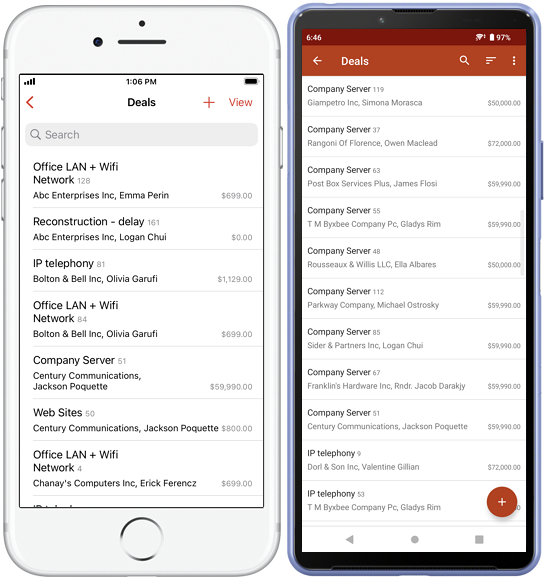
It has the look and flexibility of a spreadsheet. You can add and remove columns, filter and group data or create advanced filters. Once you created a custom layout, you can save it for future use. Learn more in the article Create Grid Reports.
Item Detail
The item detail contains all information about the item that is saved in eWay-CRM. For example, if you open a contact, you will see not only filled fields but also all relations to this contact – companies, projects, tasks, etc. If you want to create a new relation, tap the plus button.
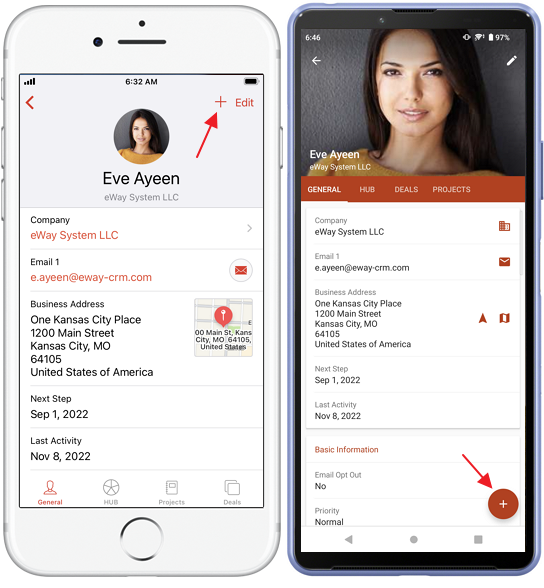
You can select what item you want to add to the opened item. You can easily add a new journal, photo, task, etc.
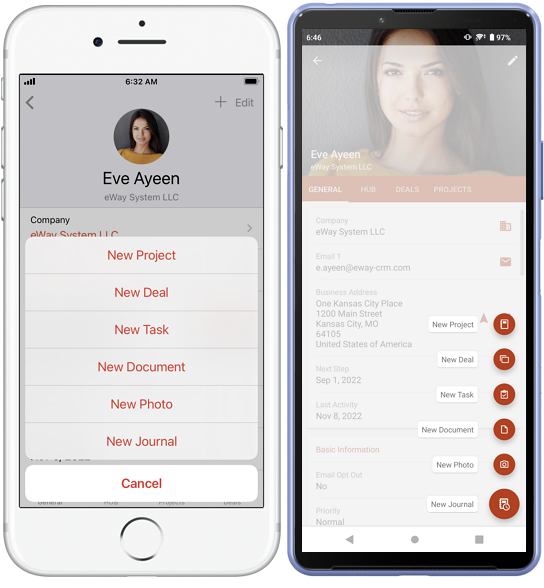
If you are creating an item or editing one, always save it. Tap the Save button.
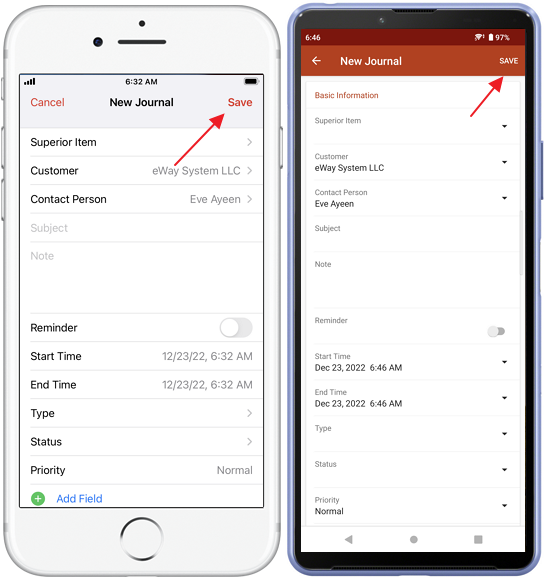
Quick Actions
You can create an item without opening the application. Just tap and hold the eWay-CRM Mobile icon and you will see the menu where you can create some items.



